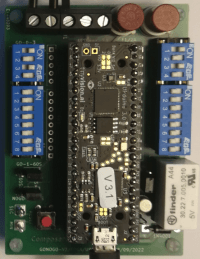GONOGO sur FPGA avec l'Upduino3.1

To go or not to go, that is the question. Are you a little lost in the development of FPGAs and the many solutions available on the market? GONOGO is made for you.
GONOGO is a programmer that periodically activates a two-contact relay (2RT) according to the following cycle: a work phase (GO) followed by a rest phase (NOGO) whose durations can be programmed according to two time resolutions:
- From 1 second to 1 hour, 8 minutes and 15 sec with a resolution of 1 second,
- From 1 minute to 2 days, 20 hours and 15 minutes with 1 minute resolution. Once the time resolutions have been chosen, the durations of the GO and NOGO phases are set using 12 switches.
Operation is based on two 12-bit counters (one for the GO and one for the NOGO) whose outputs are compared to two 12-bit vectors representing respectively the durations of the GO or the NOGO and whose values are obtained by 12 switches.
GONOGO is developed on FPGA with the Upduino3.1 board.
The article describes the technical solution but also the use of the Lattice Radiant tool. An implementation on printed circuit is also proposed.
- From 1 second to 1 hour, 8 minutes and 15 sec with a resolution of 1 second,
- From 1 minute to 2 days, 20 hours and 15 minutes with 1 minute resolution. Once the time resolutions have been chosen, the durations of the GO and NOGO phases are set using 12 switches.
Operation is based on two 12-bit counters (one for the GO and one for the NOGO) whose outputs are compared to two 12-bit vectors representing respectively the durations of the GO or the NOGO and whose values are obtained by 12 switches.
GONOGO is developed on FPGA with the Upduino3.1 board.
The article describes the technical solution but also the use of the Lattice Radiant tool. An implementation on printed circuit is also proposed.




Discussion (0 comments)